Agricola
Author: Uwe Rosenberg
Publisher: Lookout Games
Year: 2007
review by

| x |
|
|
|
|
|
|
|
|
|
|
|
|
|
|
|
|
|
|
|
|
|
|
|
|
|
|
|
|
|
|
|
|
|
|
|
|
|
|
|
|
|
|
|
|
|
|
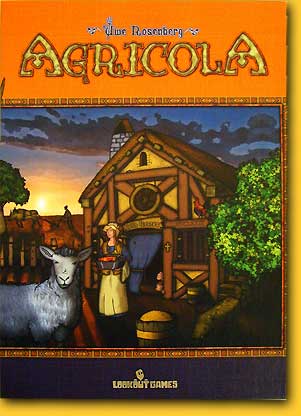 |
Central Europe, 1670. The plague that had been roaming around for centuries has finally subsided. We are picking up the pieces and start to build houses, grow crops and herd cattle. Mankind is a competitive species, and their first concern is that their house is larger than their neighbours’, the grass is greener, crops grow taller and more plentiful and the family is larger. One to five players enter this competition!
|
|
|
|
|
|
|
|
|
|
|
|
|
|
| x |
|
|
|
|
|
|
|
|
|
|
|
|
|
|
|
|
|
|
|
|
|
|
|
|
|
|
|
|
|
|
|
|
|
|
|
|
|
|
|
|
|
|
|
|
|
|
The actions that players can choose from are displayed on a central board, and during the game, more action cards are added, thus expanding our possibilities as the game progresses. At the start of the game the only actions available are basic things like chopping wood, building wooden houses and ploughing fields, but soon we learn how to build fences, bake bread, herd cattle, procreate, build brick houses, plant crops and many other useful things.
|
|
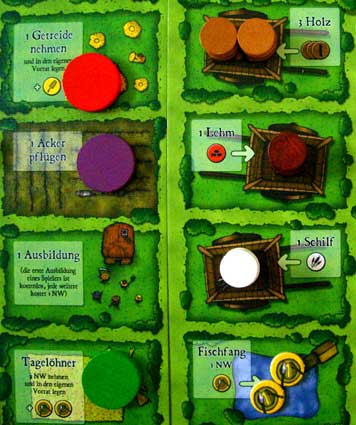 |
|
| x |
|
|
|
|
|
|
|
|
|
|
|
|
|
|
|
|
|
|
|
|
|
|
|
|
|
|
|
|
|
|
|
|
|
|
|
|
|
|
|
|
|
|
|
|
|
|
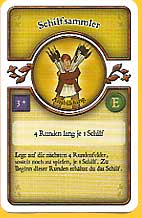 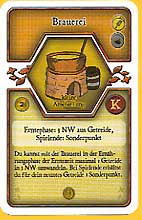 |
x |
All players receive their own board with thirteen empty fields and one wooden house with two rooms. They all start with two family members that are placed in their two rooms. Additionally, they get seven ‘job’ cards and seven ‘small item’ cards. In the next fourteen rounds, players attempt to make the best of their piece of land: grassy meadows, huge herds of cattle, fields with weaving crops, majestic stone houses filled with large families; or at least, that is their objective!
|
|
|
|
|
|
|
|
|
|
|
|
|
|
| x |
|
|
|
|
|
|
|
|
|
|
|
|
|
|
|
|
|
|
|
|
|
|
|
|
|
|
|
|
|
|
|
|
|
|
|
|
|
|
|
|
|
|
|
|
|
|
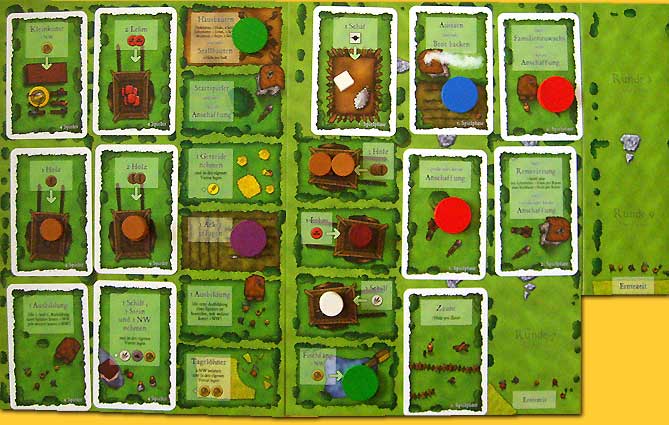 |
|
|
|
|
|
|
|
|
|
|
|
| x |
|
|
|
|
|
|
|
|
|
|
|
|
|
|
|
|
|
|
|
|
|
|
|
|
|
|
|
|
|
|
|
|
|
|
|
|
|
|
|
|
|
|
|
|
|
|
All players receive their own board with thirteen empty fields and one wooden house with two rooms. They all start with two family members that are placed in their two rooms. Additionally, they get seven ‘job’ cards and seven ‘small item’ cards. In the next fourteen rounds, players attempt to make the best of their piece of land: grassy meadows, huge herds of cattle, fields with weaving crops, majestic stone houses filled with large families; or at least, that is their objective!
At the beginning of each round, a new action card is placed on the board. The fourteen rounds are divided into six phases of four, three, three of two and one single round. The action cards are grouped by phase, so players always know which action cards can be expected in the coming rounds, but they never know in which order they will appear.
Subsequently the players place their family members on an action card, and carry out the corresponding action. Only one family member may be placed per action card!
The actions are very diverse, but they all have to do with collecting building materials (wood, clay, stone, cane), food (nutrition-tokens, grain, vegetables), life stock (sheep, wild boars, cattle), or with building (houses, fences, stables), or farming (ploughing, sowing). .
|
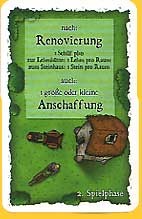 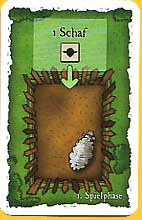 |
|
|
|
|
|
|
|
|
|
|
|
|
| x |
|
|
|
|
|
|
|
|
|
|
|
|
|
|
|
|
|
|
|
|
|
|
|
|
|
|
|
|
|
|
|
|
|
|
|
|
|
|
|
|
|
|
|
|
|
|
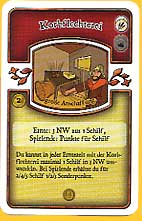 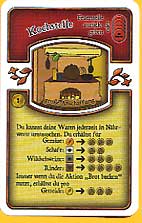 |
Also important are the actions that allow players to play a ‘job’ card or an ‘item’ card, and will give the player an extra ability or some kind of advantage for the remainder of the game.
When all family members have been placed on an action card and all actions have been performed, the round is over, the people go home and a new round begins. But there’s more! |
|
|
|
|
|
|
|
|
|
|
|
|
| x |
|
|
|
|
|
|
|
|
|
|
|
|
|
|
|
|
|
|
|
|
|
|
|
|
|
|
|
|
|
|
|
|
|
|
|
|
|
|
|
|
|
|
|
|
|
|
| At the end of each phase, six times in the game, a harvest phase takes place. The players that had sown grain or vegetables on their fields harvest one token, and subsequently all players have to feed their families. For each family member, players have to pay two nutrition tokens. There are many ways to get these; some actions allow a player to take one or more nutrition tokens, but there are also many job- or item cards that can be used to convert grain, vegetables or animals to nutrition tokens. If a player doesn’t have the required amount of nutrition tokens, he has to take a beggar-card, which will give him three minus points at the end of the game. |
x |
 |
|
|
|
|
|
|
|
|
|
|
|
|
| x |
|
|
|
|
|
|
|
|
|
|
|
|
|
|
|
|
|
|
|
|
|
|
|
|
|
|
|
|
|
|
|
|
|
|
|
|
|
|
|
|
|
|
|
|
|
|
 |
x |
After the fourteenth round, the results are compared: a scoring table is used to determine how many points the players get for their fields, pastures, houses, life stock and food supplies. Usually, minus points are awarded if a player does not possess a certain item. Empty fields score one minus point, family members score three points each, and many item cards also score points when certain criteria are met.
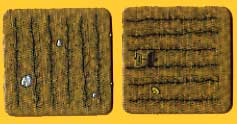 |
|
|
|
|
|
|
|
|
|
|
|
|
| x |
|
|
|
|
|
|
|
|
|
|
|
|
|
|
|
|
|
|
|
|
|
|
|
|
|
|
|
|
|
|
|
|
|
|
|
|
|
|
|
|
|
|
|
|
|
|
| x |
|
|
|
|
|
|
|
|
|
|
|
|
|
|
|
|
|
|
|
|
|
|
|
|
|
|
|
|
|
|
|
|
|
|
|
|
|
|
|
|
|
|
|
|
|
|
 |
|
|
|
|
|
|
|
|
|
|
|
|
|
|
|
|
|
|
|
|
|
|
|
|
|
|
|
|
|
|
|
|
|
|
|
|
|
|
|
|
|
|
|
Agricola is a game that one has to experience. There are 166 job cards and 136 small item cards; it is impossible to study them all in advance, and in each game players will be surprised by the fourteen different cards that they get. Players do not get additional cards during the game; the fourteen cards they start with are all they have. Nonetheless, it is possible to design a strategy based on these cards. If a player has a card that allows him to sow extra grain, and he also has a card to convert grain into a lot of nutrition tokens, he could start by ploughing some fields to sow his grain. Or, if a player has a card to convert sheep into nutrition tokens, he could start by collecting large amounts of wood to build enough stables and fences for his later in the game to be acquired sheep.
|
|
 |
|
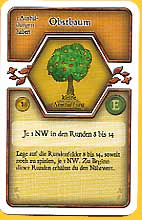 |
|
insider joke
|
|
|
|
|
|
|
|
|
|
|
|
|
|
|
|
| x |
|
|
|
|
|
|
|
|
|
|
|
|
|
|
|
|
|
|
|
|
|
|
|
|
|
|
|
|
|
|
|
|
|
|
|
|
|
|
|
|
|
|
|
|
|
|
|
|
Agricola can also be played as a ‘family game’, without the job- and small item cards. However, the game owes most of its ‘spice’ to these cards! Therefore, some facetiously refer to the family game as Agri-Cola-Light (where ‘Cola Light’ is the Dutch name for Diet Cola). For people that have difficulties with the German text on the cards, this stripped version may be a solution, but it’s much more fun with the cards included! |
|
|
|
|
|
|
|
|
|
|
|
|
| x |
|
|
|
|
|
|
|
|
|
|
|
|
|
|
|
|
|
|
|
|
|
|
|
|
|
|
|
|
|
|
|
|
|
|
|
|
|
|
|
|
|
|
|
|
|
|
It is often very frustrating how little one can do in one round; since players start out with only two family members, they can perform only two actions per round! Moreover, in the beginning of the game everybody wants to do the same thing (collect building materials!), and they often will find that the actions they would like to perform are all blocked. Later in the game this situation improves a bit; some players have focused on life stock, while others concentrate on building houses, or on agriculture. Also the number of available actions increases as the game progresses, so each player gets some more breathing space.
It is not really possible to keep an overview of what all other players are doing and how to bother them, as it is also impossible to keep track of the job- and item cards other people have played. |
x |
 |
|
|
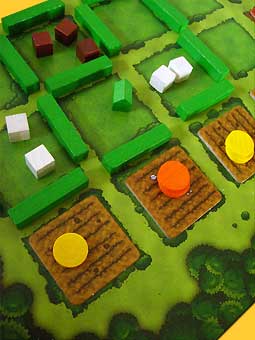 |
|
|
The print is too tiny to be able to read it from a distance, and since there are over 300 cards in the game players simply cannot recognise and remember all of them! As a consequence, there virtually is no direct interaction in the game - everyone is playing his own game on his own board. |
|
|
|
|
|
|
|
|
|
|
|
|
It is no surprise then that Agricola can be played as a single player game: try out different strategies, write down your score and try to break your personal ‘high score’ in a next game, as is the case with Civilisation-like computer simulation games. But playing together is what makes board games so much fun!
Another frustrating factor is that the game requires a really fast development; the harvesting phases are coming sooner and sooner (from four rounds, down to one round), and while each player’s family grows, the time they have to gather food for them gets shorter and shorter! This is also hard to explain from a thematic point of view; are the seasons getting shorter? Is global warming the cause of this? Or do we need more time to complete our farming tasks, despite our growing experience, and do the seasons only seem shorter?
It is quite difficult to develop oneself in all the different aspects of the game, so players have to make choices. No fields, no pastures, no sheep, cattle or boars, or empty fields on the board: everything a player does not have gives him penalty points! This is really lame, and it doesn’t really do the game a lot of good either. An often seen trick is to use the last turn to convert the empty fields on the board into one huge pasture by building fences. Even if a player does not have any animals to put in it, at least it doesn’t count as an ‘empty field’ and it won’t get him any penalty points...
|
|
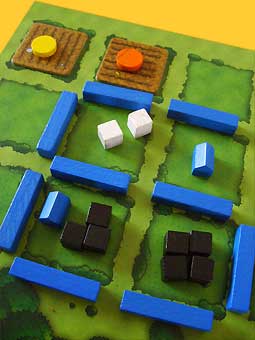 |
|
|
|
|
|
|
|
|
|
|
|
| x |
|
|
|
|
|
|
|
|
|
|
|
|
|
|
|
|
|
|
|
|
|
|
|
|
|
|
|
|
|
|
|
|
|
|
|
|
|
|
|
|
|
|
|
|
|
|
|
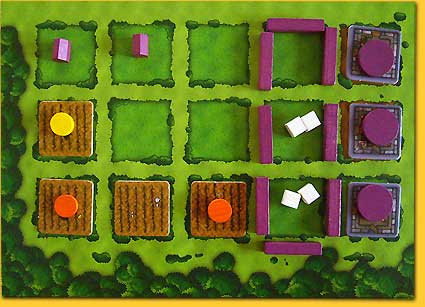
|
As for the amount of material: an impressive 2,2 kg! This is an awful lot! Over 300 cards, wooden cubes, player boards, central boards, display boards, player aid boards... but organising all this stuff before starting a game really adds to the playing time, which is already quite long as it is! It also contributes to the lack of clarity; for example, each round all sorts of cubes (clay, wood, stone, food, animals) have to be placed or added on the action cards. This really has to be executed by one player; otherwise when all are trying to help it will be total chaos, and without a doubt some cards will be skipped accidentally, while others will get new supplies multiple times. This adds to the ‘dead time’ of the game; in some cases the actual action phase is shorter than the re-supply phase...
|
|
|
|
|
|
|
|
|
|
|
|
| x |
|
|
|
|
|
|
|
|
|
|
|
|
|
|
|
|
|
|
|
|
|
|
|
|
|
|
|
|
|
|
|
|
|
|
|
|
|
|
|
|
|
|
|
|
|
|
| In conclusion, Agricola can be chaotic and messy at times, which sometimes gives the impression that we are playing a prototype instead of a smooth, polished game. Despite these criticisms, it is a promising and very rich game with many challenging aspects and different strategies to try out. Because of the variability of the job- and item cards, players don’t always have equal opportunities, and therefore Agricola should not be seen as an IQ-test! |
|
 |
|
|
|
|
|
|
|
|
|
|
What matters is: what can be done with the options available to you, by making the right decisions at the right moment. Oh, and: isn’t this just like in real life?
© 2007 Barbara van Vugt
Agricola, Uwe Rosenberg, Lookout Games, 2007 - 1 to 5 players, 12 years and up, 30 minutes per player
|
|
|
|
|
|
|
|
|
|
|
|
  |
|
|
|
|
|
|
|
|
|
|
|
|
|
|
|
|
|
|
|
|
|
|
|
|
|
|
|
|
|
|
|
|
|
|
|
|
|
|
|
|
|
|
  xxxNiNice bright, sometimes sketchy illustrations that are a sparkling change from the realistic trend xxxNiNice bright, sometimes sketchy illustrations that are a sparkling change from the realistic trend |
  |
|
|
|
|
|
|
|
|
|
|
|
|
|
|
|
|
|
|
|
|
|
|
|
|
|
|
|
|
|
|
|
|
|
|
|
|
|
|
|
|
|
|
  |
|
|
|
|
|
|
|
|
|
|
|
|
|
|
|
|
|
|
|
|
|
|
|
|
|
|
|
|
|
|
|
|
|
|
|
|
|
|
|
|
|
|
  |
|
|
|
|
|
|
|
|
|
|
|
|
|
|
|
|
|
|
|
|
|
|
|
|
|
|
|
|
|
|
|
|
|
|
|
|
|
|
|
|
|
|
| x |
|
|
|
|
|
|
|
|
|
|
|
|
|
|
|
|
|
|
|
|
|
|
|
|
|
|
|
|
|
|
|
|
|
|
|
|
|
|
|
|
|
|
|
|
|
|
| x |
|
|
|
|
|
|
|
|
|
|
|
|
|
|
|
|
|
|
|
|
|
|
|
|
|
|
|
|
|
|
|
|
|
|
|
|
|
|
|
|
|
|
|
|
|
|
 |
|
|
|
|
|
|
|
|
|
|
|
|
|
|
|
|
|
|
|
|
|
|
|
|
|
|
|
|
|
|
|
|
|
|
|
|
|
|
|
|
|
|
 |
|
|
|
|
|
|
|
|
|
|
|
|
|
|
|
|
|
|
|
|
|
|
|
|
|
|
|
|
|
|
|
|
|
|
|
|
|
|
|
|
|
|
| x |
|
|
|
|
|
|
|
|
|
|
|
|
|
|
|
|
|
|
|
|
|
|
|
|
|
|
|
|
|
|
|
|
|
|
|
|
|
|
|
|
|
|
|
|
|
|
 |
|
|
|
|
|
|
|
|
|
|
|
|
|
|
|
|
|
|
|
|
|
|
|
|
|
|
|
|
|
|
|
|
|
|
 |
|
|
|
|
|
|
|
|
|
|
|
|
|
|
|
|
|
|
|
|
|
|
|
|
|
|
|
|
|
|
|
|
|
|
|
|